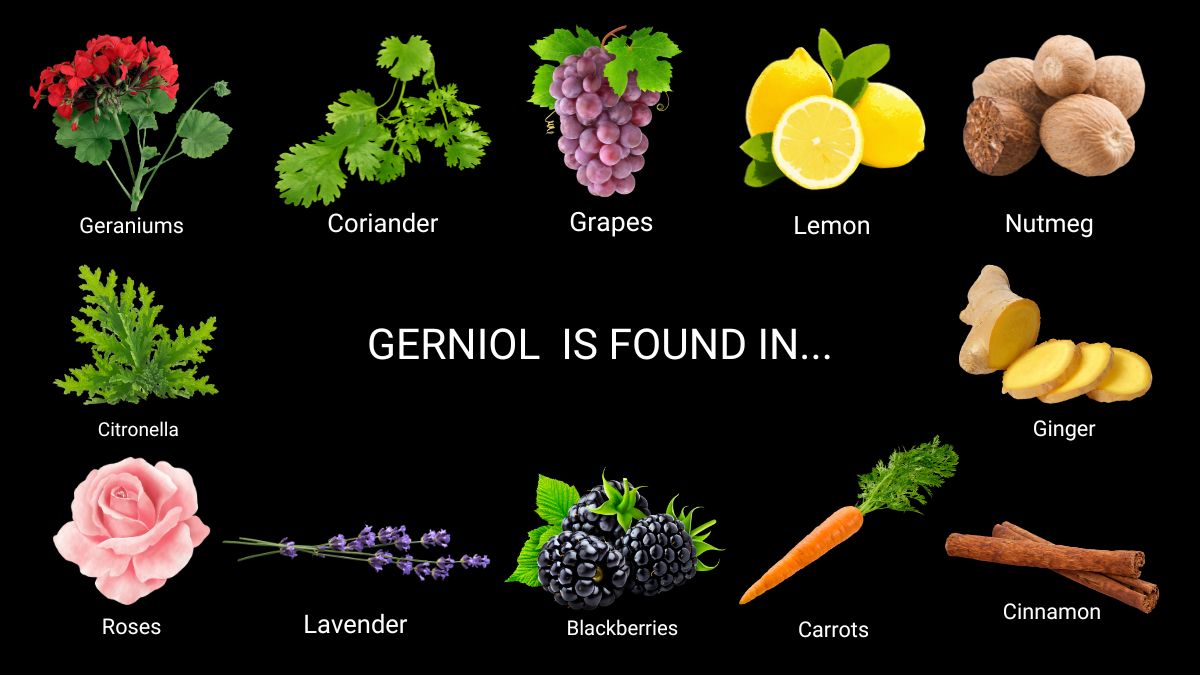Geraniol: Cannabis Terpene Guide

Imagine a world where a single compound could enhance the aroma and flavor of your favorite products, contribute to your well-being, and be safe to use. Welcome to the aromatic world of geraniol terpene! This versatile terpene not only imparts a delightful scent to various plants but also offers a multitude of potential health benefits. Uncover the essence, aroma, and sources of geraniol and its applications in cannabis, everyday products, and healthcare..
Exploring the Essence of Geraniol Terpene
Geraniol terpenes, a naturally occurring terpene, are present in the essential oils of several aromatic plant species such as cannabis, roses, geraniums, citronella, and palmarosa. Their unique sweet, floral scent has made them a popular component in plant-derived essential oils, employed in various products ranging from food additives to perfumes, fragrances, candles, and cleaning products. Despite being a lesser-known terpene, their potential therapeutic benefits have caught the attention of researchers and consumers alike.
Apart from its pleasant aroma and potential health benefits, geraniol also plays a significant role in the life of honey bees. These industrious insects use geraniol to mark nectar-bearing flowers and the entrance to their hives. This fascinating compound’s versatility doesn’t stop there, as it has been recognized as generally safe for human consumption by the FDA, making geraniol a valuable and non-toxic ingredient in various products.
The Aromatic Profile: Geraniol's Signature Scent
The captivating aroma of geraniol is at the core of its allure. Characterized by its distinct aromatic profile, geraniol imparts a unique fragrance to various perfumes, fragrances, and even cannabis strains. Its unique olfactory profile is attributed to its chemical formula C10H18O, which is the primary component of citronella oil, rose oil, and palmarosa oil, as well as being found in citrus peel.
Thanks to its unique aromatic profile, geraniol has secured a role in numerous products:
-
Perfumes and fragrances, including those inspired by natural elements like flowers
-
Food additives, used in various culinary applications
-
Cannabis items
From the fragrance industry to various applications, geraniol’s aromatic profile has found a place in numerous products
Geraniol in Nature: Sources and Secretions
Nature’s diverse tapestry has provided us with a myriad of organic compounds., and geraniol is no exception. This naturally occurring terpene can be found in an array of plants, such as:
-
Geraniums
-
Roses
-
Citronella
-
Lemons
Geraniol can also be found in some microorganisms, highlighting its presence in various environments.

Beyond its presence in plants, geraniol plays an extended role in nature. Honey bees use it to mark nectar-bearing flowers and the entrance to their hives, ensuring their fellow bees can locate these valuable resources efficiently. By appreciating geraniol’s prevalence and purpose in the natural world, we can better understand its potential applications and benefits in our own lives.
Research Interest in Geraniol
Geraniol has been studied for its interactions across various scientific domains. While no health claims can be made, research continues to examine its potential across agricultural, botanical, and environmental contexts.
Its presence in laboratory settings has led to broader interest in its biological significance, but it’s essential to underscore that any interpretation of these findings should remain within regulatory limits. All references to studies are for informational context only and do not constitute medical claims.
The Role of Geraniol in Cannabis Experience
In the world of cannabis, geraniol plays a unique role in enhancing the sensory experience of various strains. By introducing floral and citrus notes to their aroma and flavor profiles, geraniol adds depth and complexity to the overall cannabis experience. Although it may not be as prevalent as other cannabis terpenes like myrcene or caryophyllene, geraniol can still be found in a multitude of distinctive strains.
A closer examination of some cannabis strains rich in geraniol, a compound found in cannabis, will reveal their unique geraniol smell and characteristics.
Strains Rich in Geraniol
Cannabis strains high in geraniol, derived from the cannabis plant, such as:
-
Harlequin
-
Lemon G
-
Tahoe OG
-
Purple Punch
Certain cannabis strains are cultivated for their distinct aromatic profiles and cannabinoid compositions. For example, Harlequin is a sativa-dominant hybrid recognized for its high CBD content. Lemon G is a sativa strain often associated with a citrus-forward aroma. Tahoe OG, an indica-leaning hybrid, is known for its dense structure and terpene-rich profile. Purple Punch, another indica strain, is appreciated for its fruit-forward aroma and vibrant coloration.
These strains, rich in geraniol, not only provide a unique sensory experience but also contribute to the entourage effect, a phenomenon whereby the combined presence of cannabinoids, cannabis terpene, and other compounds found in cannabis can work synergistically to enhance the overall therapeutic potential of the plant. This fascinating aspect of cannabis strains showcases the versatility and potential benefits of geraniol terpene.

Practical Uses of Geraniol in Everyday Products
Geraniol’s widespread applications extend beyond the realm of healthcare and cannabis. Its pleasant sweet, floral aroma, and low toxicity make it a popular ingredient in various everyday products like cosmetics, cleaning products, insect repellents, and food additives. For instance, geraniol is a key component in skin creams, hair products, and moisturizers, providing a delightful fragrance and potential for skin care benefits.
In the cleaning and household products sector, geraniol is used in detergents, candles, and air fresheners, providing a pleasant aroma and antibacterial properties. Lastly, geraniol’s insect-repellent properties make it a valuable, non-toxic alternative to conventional bug sprays. With such a diverse array of uses, geraniol terpene proves to be a versatile and valuable compound in our daily lives.
Geraniol's Safety Profile
It’s necessary to address geraniol’s safety profile, notwithstanding the plethora of potential benefits and uses it offers. Geraniol is considered safe for human use and is classified as “Generally Regarded As Safe” by the FDA. However, some individuals may experience skin reactions when using products containing geraniol, as is the case with many essential oils.
Before using products containing geraniol, individuals with sensitive skin or those prone to allergic reactions are advised to perform a patch test to determine the risk of an allergic response. Overall, geraniol is recognized as a safe and valuable compound, but it is essential to exercise caution and be aware of potential side effects when using any new product.
Conclusion
In conclusion, geraniol terpene is a remarkable compound with a wide range of applications and potential benefits. From its delightful aroma and flavor-enhancing properties to its potential therapeutic effects and everyday uses, geraniol truly stands out as a versatile and valuable substance. As you explore the world of geraniol, you may find yourself appreciating the subtle intricacies and depth it brings to your favorite products and welcoming the possibility of improved well-being.
FAQs
Geraniol is a terpene known for its presence in a variety of products, offering a unique aroma.
Terpinolene is one of the rarest terpenes, often paired with other terpenes for its unique properties.
Geraniol is commonly found in cosmetics, cleaning products, insect repellents, and food additives due to its aromatic profile.
STIIIZY complies with all applicable state laws regarding the sale and marketing of cannabis products. This content is intended for adults 21+ in jurisdictions where cannabis use is legal under state law. By engaging with this material, you acknowledge that you are of legal age in your jurisdiction.
This content is for informational and educational purposes only. It is not intended to diagnose, treat, cure, or prevent any disease or medical condition. STIIIZY makes no health claims about cannabis products. Consult a licensed healthcare professional before using cannabis, especially if you are pregnant, nursing, or have a medical condition.
Cannabis products may affect individuals differently. Consume responsibly and avoid operating vehicles or machinery after use. STIIIZY disclaims all liability for any adverse effects, legal consequences, or misuse resulting from the use of our products or reliance on this content.
Cannabis laws vary by state and locality. This content does not constitute legal advice. Users are responsible for understanding and complying with their local regulations.
Statements about product effects or benefits are based on general industry knowledge and user experiences. Individual results may vary. STIIIZY does not guarantee specific outcomes.
References to third-party studies, testimonials, or external resources are provided for context only. STIIIZY does not endorse or validate these materials unless explicitly stated.
The views and opinions expressed in this blog are those of the author and do not necessarily reflect the official policy or position of STIIIZY.

